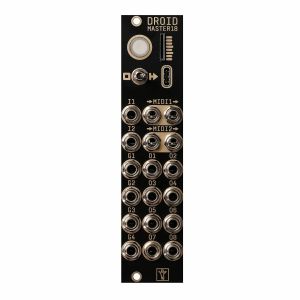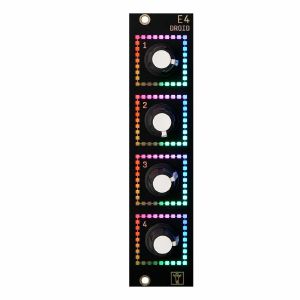Filter
Equipment
Format
Featured
Price
Tags
Back in stock: All genres
All genres vinyl represses and restocks
Artículos del 1 al 3 de 3 en la página 1 de 1
Der Mann Mit Der Maschine Droid Master 18 CV Processor Module With MIDI/USB (modular synthesiser)
Cat: 1040414 Rel: 17 Oct 24
Compact universal CV processor module with MIDI or USB
Notes: The MASTER18 is a very flexible generic CV processor.
You can think of the MASTER18 as a smaller and cheaper version of the DROID MASTER without CV inputs and LEDs, but with an integrated USB and MIDI, six additional gate jacks, two of which are inputs and four are outputs.
Details:
It has 8 CV output jacks with a voltage range from -10 V to +10 V, driven by highly accurate low jitter 16 bit DA converters:
2 gate inputs switching at 0.1 V
4 gate outputs switching between 0 V and 5 V
2 MIDI interfaces via MIDI standard B (mini jack)
MicroSD card reader and a button for reloading the MicroSD card
USB C to access the SD card from your computer or to send/receive MIDI MASTER18 comes with two interesting bonus features:
It can be connected to the Sinfonion as a follower of the Harmonic Sync.
It has an integrated tuning device for VCOs (can measure their frequency).
The MASTER18 is a good choice if you intend to just create CVs and don't need to process incoming CVs. It's perfect for building sequencers and MIDI to CV converters. MASTER18 can do almost any CV task you can imagine, such as sequencing, melody generation, slew limiting, quantizing, switching, mixing, working on clocks and triggers, creating envelopes and LFO or other fancy voltages, or any combination of these at the same time. While doing this, is very precise both in voltage and in timing.
You can attach several different DROID controller modules, such as the E4, the P2B8, the P10, the B32, the P4B2 or the M4 in order to get direct hands on access to all parameters and values of these patches.
Easily create your desired DROID patch utilizing our simple and easy-to-use editor with built in tutorials - the DROID Forge. It is available for Windows and Mac (both Apple Silicon and Intel).
The file created with the DROID Forge is a simple text file named "droid.ini" and needs to be loaded on the micro SD card that goes into the MASTER18.
… Read moreYou can think of the MASTER18 as a smaller and cheaper version of the DROID MASTER without CV inputs and LEDs, but with an integrated USB and MIDI, six additional gate jacks, two of which are inputs and four are outputs.
Details:
It has 8 CV output jacks with a voltage range from -10 V to +10 V, driven by highly accurate low jitter 16 bit DA converters:
2 gate inputs switching at 0.1 V
4 gate outputs switching between 0 V and 5 V
2 MIDI interfaces via MIDI standard B (mini jack)
MicroSD card reader and a button for reloading the MicroSD card
USB C to access the SD card from your computer or to send/receive MIDI MASTER18 comes with two interesting bonus features:
It can be connected to the Sinfonion as a follower of the Harmonic Sync.
It has an integrated tuning device for VCOs (can measure their frequency).
The MASTER18 is a good choice if you intend to just create CVs and don't need to process incoming CVs. It's perfect for building sequencers and MIDI to CV converters. MASTER18 can do almost any CV task you can imagine, such as sequencing, melody generation, slew limiting, quantizing, switching, mixing, working on clocks and triggers, creating envelopes and LFO or other fancy voltages, or any combination of these at the same time. While doing this, is very precise both in voltage and in timing.
You can attach several different DROID controller modules, such as the E4, the P2B8, the P10, the B32, the P4B2 or the M4 in order to get direct hands on access to all parameters and values of these patches.
Easily create your desired DROID patch utilizing our simple and easy-to-use editor with built in tutorials - the DROID Forge. It is available for Windows and Mac (both Apple Silicon and Intel).
The file created with the DROID Forge is a simple text file named "droid.ini" and needs to be loaded on the micro SD card that goes into the MASTER18.
1 in stock $351.28
Der Mann Mit Der Maschine E4 Encoder Controller Module (controller module)
Cat: 1005283 Rel: 07 Mar 24
Encoder controller module - 6HP
Notes: E4 Encoder Controller
The E4 is a controller with four rotary encoders.
The encoders look like normal potentiometers, but you can turn them endlessly in either direction. (Don't be fooled by the knobs, which do have a pointer).
This allows for a wide range of applications and great flexibility.
Each encoder is surrounded by a square of 32 multicolor LEDs. This LED ring is used to indicate the current value of the encoder. And it looks really great! The LEDs help you to give you an orientation by displaying the current value.
Each encoder contains a push button, which can be used just like those on the P2B8 or on the B32.
The E4 is perfect for mapping many different functions or presets to one encoder and then switch with the buttons of a P2B8 or B32 to some other context. Because of the LED rings you instantly see the current value after switching. And other than with pots, no "picking up" of the value is needed.
Furthermore, the nature of the encoders allows for some useful features, for example:
Create a "multi turn" pot, that needs to be turned several rounds for going through the total range (which allows for a finer selection).
Enable a mode where a slow movement of the encoder changes the value even slower, so it allows for instant fine tuning.
Use an encoder as a switch with a fixed number of positions (the LEDs visualise that)
Select a bipolar value with proper visualisation by the LEDs.
Use an encoder for "strumming", where you get triggers when it is turned.
As a bonus, there is a circuit called encoquencer, that allows you to build a melody sequencer based on the encoders and LEDs of the E4. It has the same features as the sequencer that is based on the motor faders of the M4 (motoquencer).
Power consumption:
+12V: 220 mA when all LEDs are white, 53 mA during normal use case
-12V: 0 mA
5V: 0 mA
Hint: The LEDs only shine fully white when you set them up to do so in your DROID patch. As long as you use the encoders in a normal way, the LEDs display colored light which is not as bright, so the power consumption is much less under normal circumstances.
Dimensions
6 HP
23 mm deep
Current Draw
53 mA +12V
0 mA -12V
0 mA 5V
… Read moreThe E4 is a controller with four rotary encoders.
The encoders look like normal potentiometers, but you can turn them endlessly in either direction. (Don't be fooled by the knobs, which do have a pointer).
This allows for a wide range of applications and great flexibility.
Each encoder is surrounded by a square of 32 multicolor LEDs. This LED ring is used to indicate the current value of the encoder. And it looks really great! The LEDs help you to give you an orientation by displaying the current value.
Each encoder contains a push button, which can be used just like those on the P2B8 or on the B32.
The E4 is perfect for mapping many different functions or presets to one encoder and then switch with the buttons of a P2B8 or B32 to some other context. Because of the LED rings you instantly see the current value after switching. And other than with pots, no "picking up" of the value is needed.
Furthermore, the nature of the encoders allows for some useful features, for example:
Create a "multi turn" pot, that needs to be turned several rounds for going through the total range (which allows for a finer selection).
Enable a mode where a slow movement of the encoder changes the value even slower, so it allows for instant fine tuning.
Use an encoder as a switch with a fixed number of positions (the LEDs visualise that)
Select a bipolar value with proper visualisation by the LEDs.
Use an encoder for "strumming", where you get triggers when it is turned.
As a bonus, there is a circuit called encoquencer, that allows you to build a melody sequencer based on the encoders and LEDs of the E4. It has the same features as the sequencer that is based on the motor faders of the M4 (motoquencer).
Power consumption:
+12V: 220 mA when all LEDs are white, 53 mA during normal use case
-12V: 0 mA
5V: 0 mA
Hint: The LEDs only shine fully white when you set them up to do so in your DROID patch. As long as you use the encoders in a normal way, the LEDs display colored light which is not as bright, so the power consumption is much less under normal circumstances.
Dimensions
6 HP
23 mm deep
Current Draw
53 mA +12V
0 mA -12V
0 mA 5V
1 in stock $183.13
Click for better price!
or call +44 20 7424 1960
quote 1005283
quote 1005283
Der Mann Mit Der Maschine P8S8 Slider & Switch Controller Module (slider & switch control module)
Cat: 1056311 Rel: 03 Mar 25
8 HP slider & switch controller module for those who love those little sliders
Notes: The P8S8 controller is for those who love those little sliders. The sliders behave like regular pots, so we named the module P8S8 (the "S" stands for the switches).
The P8S8 has eight Alpha sliders with a range of 20 mm. As a speciality the sliders contain LEDs. Their brightness can be controlled and used for any purpose. As long as you don't use the LED registers, the brightness of the LEDs reflect the current slider positions.
At the bottom the P8S8 has eight 3-way toggle switches.
As always in the DROID universe, it can be patched as whatever comes to mind, but looking at this module, it's almost imposing to be used as modulation sequencer or ADSR controller.
Shipping includes a short ribbon cable for connecting the controller to the master or to the previous controller. If you want to place the controller further away from the master, you can purchaser longer ribbon cables here in the shop.
Current Draw: 20 mA +12V, 0 mA -12V, 0 mA 5V
Width: 8 HP
Depth: 25 mm
… Read moreThe P8S8 has eight Alpha sliders with a range of 20 mm. As a speciality the sliders contain LEDs. Their brightness can be controlled and used for any purpose. As long as you don't use the LED registers, the brightness of the LEDs reflect the current slider positions.
At the bottom the P8S8 has eight 3-way toggle switches.
As always in the DROID universe, it can be patched as whatever comes to mind, but looking at this module, it's almost imposing to be used as modulation sequencer or ADSR controller.
Shipping includes a short ribbon cable for connecting the controller to the master or to the previous controller. If you want to place the controller further away from the master, you can purchaser longer ribbon cables here in the shop.
Current Draw: 20 mA +12V, 0 mA -12V, 0 mA 5V
Width: 8 HP
Depth: 25 mm
6 in stock $154.87
Click for better price!
or call +44 20 7424 1960
quote 1056311
quote 1056311
Artículos del 1 al 3 de 3 en la página 1 de 1

 USD
USD








